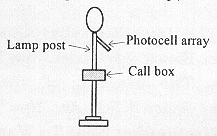| A silly
device
Safety isn't silly
Photovoltaic collectors
aren't silly Putting them a few inches
from a source of electricity is very silly. The truth hides the lie
It's now 2000
Delusional optimism
The problem is weak sunlight,
not weak technology |
If I had not been so lazy, I would have taken a photograph, but instead,
I made a crude drawing (Fig. 3) of a silly solar- powered emergency telephone
that I walk by every day. Of course, it works at night (when it is most likely
to be needed) as well as it does in the day, because the solar cells keep
a battery charged.
No, I am not saying it’s silly to have an emergency telephone on a campus; not everybody is here to receive the wisdom of the faculty. The system is silly, nonetheless. 
Photovoltaic arrays are expensive, as we (and everybody else) have repeatedly pointed out. But that’s hardly an issue when an emergency is involved. In particular, Michael Darby of Australia has told me of one such solar-powered telephone in Middleton (population = 2) located 100 miles from the nearest power lines. But on the UConn campus, why buy the expensive solar cell array when power lines are a few centimeters away? Australia is not, however, the land of eternal sanity. Darby tells
me, “In Clonurry North Queensland where I lived at 21 degrees latitude solar
hot water systems were pushed hard by the conservationists, but to persuade
people to buy them, the State government had to offer a cash bribe of A$400.”
Darby’s website, Solar Delusions in Perspective
Denis Hayes, Head Solar Energy Research Inst. (SERI)
(1977)
It is also true that well over 90% of the milk sold
in the US comes from cows and bears. The phony part of Hayes’s true
statement is the link-up between the two sources that supply the lion’s share
of the energy (biomass and water power) and the two piddle-power sources
that provide a minuscule fraction of the total (wind and direct sunlight).
Denis Hayes, (1977)
Obviously, Hayes’s prediction for year 2000 was far-fetched. In 1998, about one-fifth of the energy used around the globe comes from solar sources, just as it did when Hayes made this erroneous prediction. The solar contribution did not double (i.e., from 20% to 40%) in the two decades 1977-1998. But no scientist worth his salt needs the benefit of hindsight to spot Hayes’s errors. The delusional optimism was obvious from the outset. It isn’t hard to imagine why such ridiculously optimistic predictions fail. Firewood is a very limited resource everywhere firewood is regularly used as the primary energy source, such as equatorial Africa, so that contribution won’t double. The largest, easiest-to-use hydropower sites (such as Niagara Falls, Hoover Dam, …) are already in use. To double the output of hydropower would obviously involve damming many smaller rivers with much lower “head” (height of water column) dams. The fact that direct sunlight and wind power have always been inadequate
sources doesn’t deter those who think laws of physics were written by Congressmen
to benefit lobbyists:
Denis Hayes, (1977)
|